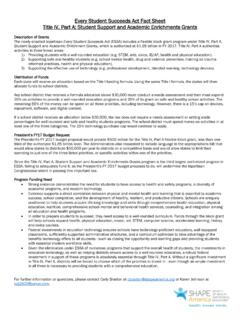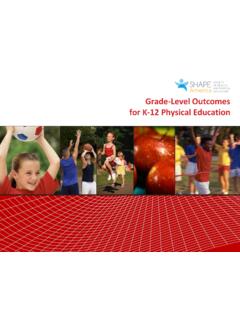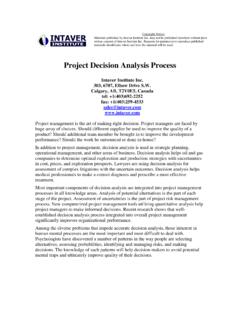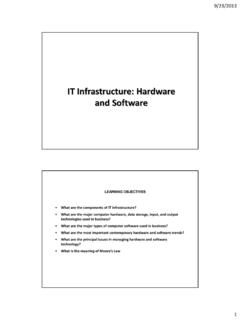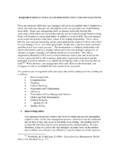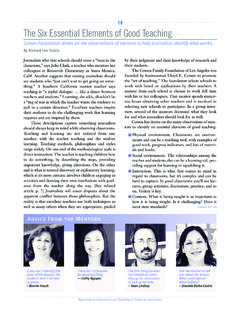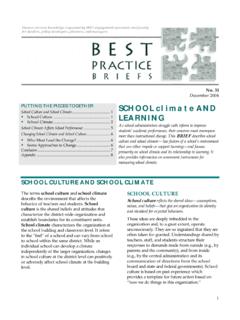Transcription of Guidance Document - SHAPE America
1 2015, SHAPE America Society of Health and Physical Educators Association Drive, Reston, VA 20191 Fax Essential Components of Physical Education1 Over the past two decades, physical education has undergone a transformation in rigor and focus and now is recognized as essential to a young person s overall education experience and a foundation for lifelong healthy America has helped spearhead that transformation and, in the past year alone, redefined physical education in its book, National Standards & Grade-Level Outcomes for K-12 Physical Education (2014), as the pursuit of physical literacy (Figure 1), which parallels the terminology used in other subjects such as health and mathematics. The new National Standards (Figure 2) and their accompanying Grade-Level Outcomes identify the skills and knowledge necessary to support the development of physically literate individuals: those who have the knowl-edge, skills and confidence to enjoy a lifetime of physical activity ( SHAPE America , 2014, p.)
2 4).More recently, SHAPE America has re-envisioned the essential components that provide the structure for a physi-cal education program (p. 4). The purpose of this Document is not only to delineate those essential components, but also to identify physical education as a key element of a well-rounded education for all students. National Recommendation and FrameworkIn 2008, the Department of Health and Human Services issued 2008 Physical Activity Guidelines for Americans, age 6 and older, which recommend that children and adolescents should engage in The Essential Components of Physical EducationGuidance DocumentFigure 1. Physical LiteracyTo pursue a lifetime of healthful physical activi-ty, a physically literate individual: Has learned the skills necessary to partici-pate in a variety of physical activities. Knows the implications and the benefits of involvement in various types of physical activities. Participates regularly in physical activity. Is physically active.
3 Values physical activity and its contributions to a healthful lifestyle. National Standards & Grade-Level Outcomes for K-12 Physical Education (2014), SHAPE America . 2015, SHAPE America Society of Health and Physical Educators Association Drive, Reston, VA 20191 Fax America260 minutes or more of physical activity daily (USDHHS, 2008, p. 16). The comprehensive school physical activity program (CSPAP) (Figure 3) has been recognized as the new national framework for physical education and physical activity for young people (CDC, 2014, p. 2). This framework supports physical activity participation among young people as recommended in the National Physical Activity Plan (National Physical Activity Plan Alliance, 2010). A CSPAP not only educates youth in the knowledge and application of skills learned, but also mobilizes them to apply what they have learned and adopt a healthy life-style. A CSPAP is a multi- component approach by which school districts and schools use all opportunities for students to be physically active throughout the school day in order to meet the national physical activity recommen-dation (CDC, 2013, p.)
4 12). A CSPAP reflects strong coordination and syn-ergy across all of its five components: physical education as the foundation, physical activity during school, physical activity before and after school, staff involvement, and family and community engagement (CDC, 2013, p. 12). At the heart of the new framework, physical education provides youth with the funda-mental education and skills needed to make decisions regarding physical activity. Physical activity during the school day includes active recess, physical activity integrated into classroom lessons, physical activity breaks in and outside the classroom, and lunchtime club or intramural programs. These opportunities must be offered to all grade levels and must not exclude middle and high school students, who will benefit from engaging in physi-cal activity throughout the school day (CDC, 2013, p. 14). Physical activity before and after school provides opportu-nities for all students to practice what they have learned in physical education and become more adequately prepared for learning.
5 School employees play an integral role in a school s CSPAP by committing to good health practices and serving as positive role models for students by demonstrat-ing active lifestyle choices in and out of school. Family and Figure 3. Comprehensive School Physical Activity Program (CSPAP)StaffInvolvementPhysicalActivityD uring SchoolPhysicalEducationPhysical ActivityBefore andAfter SchoolFamily andCommunityEngagementCSPAPF igure 2. National Standards for K-12 Physical Education The physically literate individual demonstrates compe-tency in a variety of motor skills and movement physically literate individual applies knowledge of concepts, principles, strategies and tactics related to movement and physically literate individual exhibits responsible personal and social behavior that respects self and physically literate individual demonstrates the knowledge and skills to achieve and maintain a health-enhancing level of physical activity and physically literate individual recognizes the value of physical activity for health, enjoyment, challenge, self-expression and/or social 1 STANDARD 2 STANDARD 4 STANDARD 3 STANDARD 5 2015, SHAPE America Society of Health and Physical Educators Association Drive, Reston.
6 VA 20191 Fax Essential Components of Physical Education3community engagement in school-based physical activity programs provides health benefits and positive influences, and creates a connection between schools and community-based programs (CDC, 2013, p. 14).Physical Education: The Foundation of CSPAPP hysical education is an academic subject and serves as the foundation of a CSPAP and, as such, demands the same education rigor as other core subjects. Physical education provides students with a planned, sequential, K-12 standards-based program of curricula and instruction designed to develop motor skills, knowledge and behaviors for active living, physical fitness, sportsmanship, self-efficacy and emotional intelligence. During physical education, students practice the knowledge and skills they learn through physical activi-ty, which is defined as any bodily movement that results in energy expenditure. Students also engage in exercise any physical activity that is planned, structured and repetitive for the purpose of improving or maintaining one or more components of fitness (CDC, 2013, p.)
7 8). It is important to clarify the common technical language used in physical education; the terms physical education, physical activity and exer-cise often are used interchangeably but clearly, they define three very different things. (Figure 4)PHYSICAL ACTIVITYP hysical activity is any bodily movement that results in energy is any physical activity that is planned, structured and repetitive for the purpose of improving or maintaining one or more components of EDUCATIONP hysical education is an academic subject that provides a planned, sequential, K-12 standards-based program of curricula and instruction designed to develop motor skills, knowledge and behaviors for healthy, active living, physical fitness, sportsmanship, self-efficacy and emotional 4. Defining Physical Activity, Exercise and Physical EducationPhysical education develops the physically literate individual through deliberate practice of well-designed learning tasks that allow for skill acquisition in an instructional climate focused on mastery ( SHAPE America , 2014, p.
8 10). Physical education addresses the three domains of learning: cognitive or mental skills related to the knowledge of movement; affective, which addresses growth in feelings or attitudes; and psychomotor, which relates to the manual or physical skills related to movement literacy ( SHAPE America , 2014, p. 4).A well-designed physical education program: Meets the needs of all students; Keeps students active for most of physical education class time; Teaches self-management; Emphasizes knowledge and skills for a lifetime of physical activity; and Is an enjoyable experience for all students (CDC, 2013, p. 12). 2015, SHAPE America Society of Health and Physical Educators Association Drive, Reston, VA 20191 Fax America4 The Essential Components of Physical Education Physical education (Figure 5) includes four essential components that provide the structure for this fundamen-tal subject area: 1. Policy and environment;2. Curriculum;3. Appropriate instruction; and4.
9 Student assessment. Defining the essential components of physical education raises awareness for the critical policies and practices that guide school districts and schools in addressing stu-dents education needs. School districts and schools also must establish the written curriculum that defines what is to be taught, guides rigorous instruction that supports the curriculum and identifies student assessment that will provide evidence of student and EnvironmentSchool districts and schools define physical education expec-tations through specific physical education policy and policy Guidance . Well-defined policy helps create an environment that ensures that all students receive physical education that defines student outcomes clearly. It also increases consisten-cy in the delivery of education to students. The physical education policies listed in Figure 6 should be included in the required local school wellness policy and should identify the program elements, environmental metrics and expected standards for all students.
10 Strong policy is important to ensuring that state requirements are implement-ed throughout school districts and schools at all grade levels, for all students. Policy language such as the terms waivers, exemptions and substitutions can be confusing and often needs clarifica-tion. State-level policy may exist regarding waivers, exemp-tions and substitutions. When state-level policies regarding waivers, exemptions and/or substitutions are in place, school district and school policies must align with them. In the ab-sence of state-level policies, school districts and/or schools Figure 6. Policy and Environment Every student is required to take daily phys-ical education in grades K-12, with instruc-tion periods totaling 150 minutes/week in elementary and 225 minutes/week in middle and high school. School districts and schools require full inclu-sion of all students in physical education. School districts and schools do not allow waivers from physical education class time or credit requirements.
